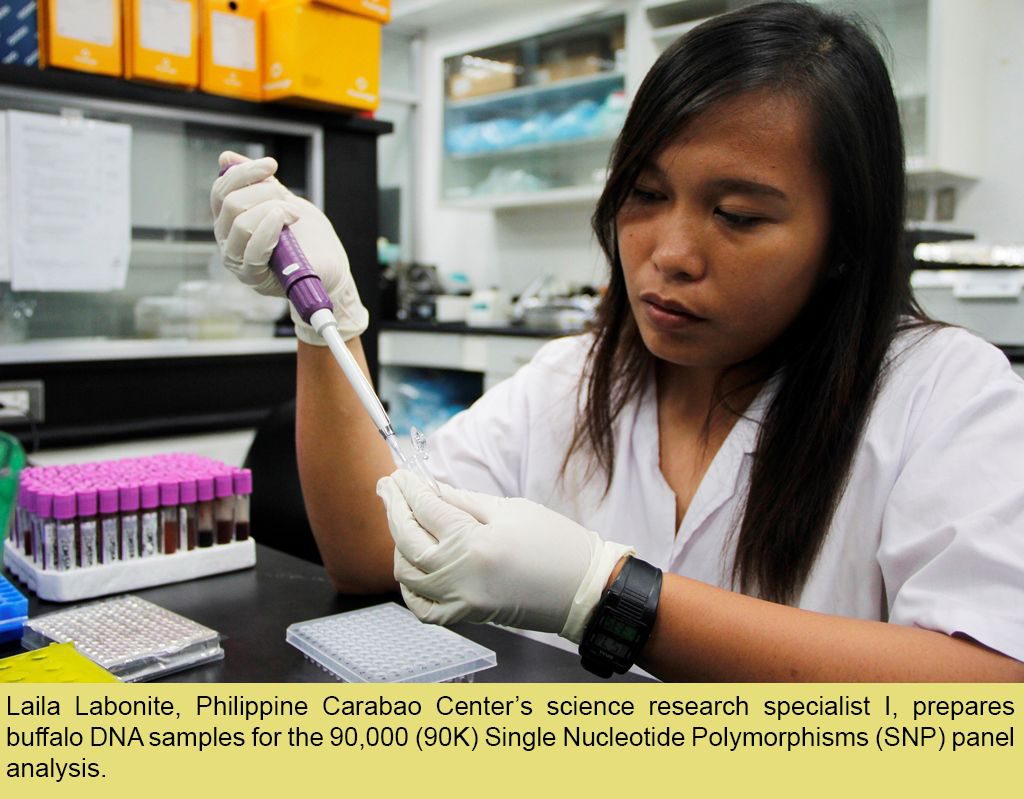The Philippine Carabao Center (PCC) is undertaking a new research study aimed at improving the production efficiency of buffaloes and the rate of genetic gain of the animals through the use of genomic information in breeding and selection.
This was revealed by Dr. Ester Flores, head of PCC’s genetic improvement program (GIP) unit and lead researcher of the study.
Titled “Application of genomic information in dairy buffalo breeding program: Genotyping the Philippine water buffaloes using medium density 90,000 (90K) buffalo Single Nucleotide Polymorphisms (SNP) panel”, the study has two components: genome-wide association studies (GWAS) for milk production traits in Philippine dairy buffaloes, and development and application of genomic selection in buffalo breeding program.
“It is being conducted to further expand the number of SNP markers that we currently have in marker- assisted selection (MAS) of our carabaos and to help us set up a reference population (information nucleus) for our dairy buffaloes for use in genomic selection. ,” Flores said.
It is also meant to provide us (the researchers) knowledge and skills in analyzing and utilizing dense genomic information that we can use in our buffalo breeding program, she added.
“To do this, we will use an advance technology to identify a set of DNA markers that will enable us to identify which among our animals have high genetic merit in terms of their milk production and milk component traits. The technology that we are going to use is the medium density 90k SNP chip,” she revealed.
Medium density 90k SNP chip
According to Flores, the medium density 90k SNP chip is a type of DNA microarray that is being used to detect polymorphisms (occurrence of two or more clearly different phenotypes or characteristics in the same population of a species) in the buffalo’s genes.
She said that this chip contains 90,000 DNA markers that can help identify which among the animals are carrying a favorable allele on its gene and, thus, good for use in the breeding program implementation to further improve the buffalo’s breed.
“The 90k SNP chip is considered as an advanced technology in identifying DNA markers for various or specific traits of carabaos. It was designed through the Expert Design Program facilitated by Affymetrix, which is a pioneer in microarray technology and a leader in genomics analysis, and the only commercially available high-density buffalo genotyping tool,” Flores explained.
She added that, the PCC is the first agency in the Philippines to use this technology.
Genome-wide association studies (GWAS)
According to the cited literature of the research study, GWAS is now a preferred method for exploring genes associated with quantitative traits and has advantages over quantitative trait loci (QTL) mapping through linkage analysis as it results in greater power of detection. Further, it gives more precise QTL position estimates because it exploits the linkage disequilibrium between the marker and QTL at the population level of the specific DNA marker of the buffaloes.
In the research study, GWAS will be used to analyze the association between markers and phenotype of the gathered SNP markers to determine a list of significant markers associated with milk production and milk component traits of the animals DNA samples that were sent to the laboratory for genotyping using the 90k SNP chip panel. The significant SNP markers that will be identified are valuable for genomic selection of dairy buffaloes in the future.
Genomic selection in buffalo breeding program
Genomic selection, as defined in the research study, is one method to further predict the breeding value of an animal based on its genotype from a dense panel of single nucleotide polymorphism (SNP) markers regularly spaced throughout the whole genome of the buffalo’s DNA.
In fact, as Flores pointed out, a lot of livestock industries in other countries, most notably on dairy cattle, have been implementing genomic selection for several years already with successful results. The proportion of sires used as semen donor for artificial insemination that are non-progeny tested but have genomic breeding values is growing on a yearly basis even in species or breeds with small population. This is a reflection of the confidence of the industry on genomic selection.
In the current research study, development and application of genomic selection is one of the target outputs of the research. By using this, faster generation interval will be achieved and identification of buffaloes having high genetic merits in terms of its milk production and milk component traits will be identified in a lesser time because they are directly working and evaluating the buffaloes’ gene, Flores said.
She added that it is very efficient in spotting genetically superior animals that are best to use in the breeding program implementation.
“One way to do that is to have higher accuracy of selection by means of adding additional parameter like of genotyping the dairy buffaloes,” she added.
Expected outputs
The following are the expected deliverables of the study:</>
- On the first year of the study, the research is expected to provide genomic information from 90K SNP panels of 900 cows or buffaloes with phenotype and identify 12 significant SNP markers from the buffaloes DNA’s.
- On its second year, it is expected to identify eight young bulls nominated or selected for breeding based on its best lineal and bias prediction and estimated breeding values (BLUP EBVs) and its genotype information based on the significant SNP markers that will be derived; and provide population stratification of local riverine type of buffaloes.
- On the third year, it is expected to determine the effect of each and every SNP solutions using GWAS; to derive a model on estimating the Genomic Breeding Values (GEBV) of the animals in the information nucleus; increase accuracy of selection of buffaloes based on Parent Average Estimated Breeding Values (PAEBV) 0.46 to GEBV 0.56; and finally, to identify eight young bulls nominated and selected for breeding based on its BLUP EBVs and GEBVs.

